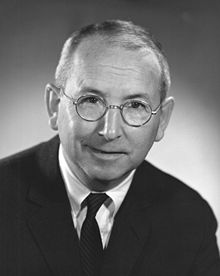Paul D. MacLean
This article includes a improve this article by introducing more precise citations. (June 2018) ) |
Paul D. MacLean | |
|---|---|
 | |
| Born | 1 May 1913 Phelps, New York |
| Died | 26 December 2007 Potomac |
| Education | Doctor of Medicine |
| Alma mater | |
| Awards |
|
| Academic career | |
| Institutions |
|
Paul Donald MacLean (May 1, 1913 – December 26, 2007) was an American
Biography
Paul D. MacLean was born in
During
After leaving the Army in 1946, MacLean practiced medicine in Seattle, and held a clinical appointment at the University of Washington Medical School. From 1947 to 1949, MacLean was a United States Public Health Service Fellow at Harvard Medical School/Massachusetts General Hospital, studying with Dr. Stanley Cobb. During this time, MacLean did research on psychomotor epilepsy, and published his paper on the "visceral brain", for which he introduced the term "limbic system" in 1952).
In 1949, MacLean joined the faculty of the
In 1956, MacLean became associate professor of physiology. He spent a year on a National Science Foundation Senior Postdoctoral Fellowship at the Institute of Physiology in Zürich, Switzerland.
In 1957, MacLean went to the National Institutes of Health as the head of a new section on the limbic system in the Laboratory of Neurophysiology, National Institute of Mental Health (NIMH). MacLean received the Distinguished Research Award of the Association for Research in Nervous and Mental Disease in 1964, and in 1966 gave the Thomas William Salmon Lectures at the New York Academy of Medicine. MacLean also received the G. Burroughs Mider Lectureship Award from the NIH in 1972.
In 1971 MacLean became the Chief of the Laboratory of Brain Evolution and Behavior, NIMH, newly opened in Poolesville, Maryland. MacLean was chief of the Laboratory of Brain Evolution and Behavior from 1971 to 1985. The laboratory was designed for comparative neurobehavioral research on animals in semi-natural conditions. MacLean retired with the NIH honor of senior research scientist, emeritus in the Department of Neurophysiology at NIMH.
MacLean's ideas were popular among popular authors such as Carl Sagan and Arthur Koestler.
Correspondence, photographs, research materials, reports, writings, and audiovisual materials (1936; 1944-1993) held by the National Library of Medicine document the official portion of MacLean's career in brain and behavioral research. He died in Potomac, Maryland on December 26, 2007.
Sources
- National Library of Medicine
- Pearce, Jeremy (January 10, 2008). "Paul MacLean, 94, Neuroscientist Who Devised 'Triune Brain' Theory, Dies". The New York Times. Retrieved June 2, 2018.
See also
Further reading
- Newman, John D; Harris James C (Jan 2009). "The scientific contributions of Paul D. MacLean (1913-2007)". S2CID 52864889.
- Olry, Régis; Haines Duane E (Dec 2005). "NEUROwords: from Dante Alighieri's first circle to Paul Donald MacLean's limbic system". S2CID 33714585.
- Lambert, Kelly G. (2003). "The life and career of Paul MacLean: A journey toward neurobiological and social harmony". Physiology and Behavior. Vol. 79, no. 3. Elsevier. pp. 343–349. .
- MacLean, Paul D. (1998). "Paul D. MacLean". In Squire, Larry R. (ed.). The history of neuroscience in autobiography. Vol. 2. Bethesda, Md: Society for Neuroscience (published 1996). pp. 242–275. OCLC 36433905.
